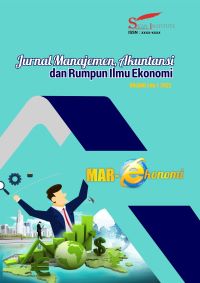The Role of Big Data Technology in HRM Decision Making
Keywords:
Big Data, Decision Making, Human Resource Management (HRM), Effectiveness, EfficiencyAbstract
This research aims to explore and analyze the role of Big Data technology in the context of Human Resource Management (HRM) decision making. The development of information technology, especially Big Data, has enabled organizations to collect, store and analyze large and varied volumes of data quickly. In the context of HRM, Big Data technology promises great potential in improving the quality of decision making related to employee management, recruitment, employee development, performance evaluation and talent management. The research method used is a qualitative approach with descriptive methods. The research results show that the application of Big Data technology in Human Resource Management (HRM) decision making provides great potential for increasing the effectiveness and efficiency of the workforce management process. By analyzing employee data from various sources, organizations can identify trends, patterns and opportunities that are undetectable through conventional methods, and predict future workforce needs. However, challenges such as data privacy, the complexity of data integration, and the need for strong analytical skills, must be overcome so that the application of Big Data in HRM can provide maximum benefits for companies. With a holistic and integrated approach, organizations can harness the potential of Big Data to improve HR strategies, improve employee performance, and achieve larger business goals.
References
Anggito, A., & Setiawan, J. (2018). Konsep dasar penelitian kualitatif. Dalam Metodologi Penelitian Kualitatif.
Davenport, T. H., & Dyché, J. (2013). Big data in big companies. International Institute for Analytics, 3(1-31).
Hamizar, A. (2023). Implementasi Strategi Manajemen Transformatif Dalam Pengembangan Kapabilitas Berbasis Manajemen Talenta Pegawai. Advantage: Journal of Management and Business, 1(2), 69-80.
Hofmann, E. (2017). Big data and supply chain decisions: the impact of volume, variety and velocity properties on the bullwhip effect. International Journal of Production Research, 55(17), 5108-5126.
Kurniawan, S. D., Widiastuti, R. Y., Hermanto, D. M. C., Mukhlis, I. R., Pipin, S. J., Surianto, D. F., ... & Judijanto, L. (2024). Big Data: Mengenal Big Data & Implementasinya di Berbagai Bidang. PT. Sonpedia Publishing Indonesia.
Moleong, L. J. (2014). Metode penelitian kualitatif edisi revisi. Bandung: PT Remaja Rosdakarya, 5(10).
Mukhtar, A., & Masradin, M. (2023). Bagaimana Teknologi Era 4.0 Menerapkan Rekrutmen?(Kajian Manajemen Sumber Daya Manusia). Paraduta: Jurnal Ekonomi dan Ilmu-Ilmu Sosial, 1(2), 77-89.
Nikmah, W., Mukarromah, A., Widyansyah, D., & Anshori, M. I. (2023). Penggunaan Teknologi Dalam Pengembangan SDM. Mutiara: Jurnal Penelitian dan Karya Ilmiah, 1(5), 366-386.
Pratama, A. S., Sari, S. M., Hj, M. F., Badwi, M., & Anshori, M. I. (2023). Pengaruh Artificial Intelligence, Big data dan otomatisasi terhadap kinerja SDM di Era digital. Jurnal Publikasi Ilmu Manajemen, 2(4), 108-123.
Ramadhani, F., & Arifin, Y. (2013). Optimalisasi pemanfaatan teknologi informasi komunikasi berbasis e-commerce sebagai media pemasaran usaha kecil menengah guna meningkatkan daya saing dalam menghadapi masyarakat ekonomi Asean 2015. Economics Development Analysis Journal, 2(2).
Samad, A. W. (2022). Analisis Data Sumber Daya Manusia Dalam Isu-Isu Global. Indonesian Journal of Business Analytics, 2(1), 99-110.
Setyawan, A. A., & Kuswati, R. (2006). Teknologi informasi dan reposisi fungsi manajemen sumber daya manusia.
Sheth, A. (2014, March). Transforming big data into smart data: Deriving value via harnessing volume, variety, and velocity using semantic techniques and technologies. In 2014 IEEE 30th International Conference on Data Engineering (ICDE) (pp. 2-2). IEEE Computer Society.
Siagian, A. O. (2021). Manajemen Talenta Terintegrasi. Pengantar Manajemen Talenta, 87.
Sudiantini, D., Naiwasha, A., Izzati, A., & Rindiani, C. (2023). Penggunaan Teknologi Pada Manajemen Sumber Daya Manusia Di Dalam Era Digital Sekarang. Digital Bisnis: Jurnal Publikasi Ilmu Manajemen dan E-Commerce, 2(2), 262-269.
Sugiana, N. S. S., & Musty, B. (2023). Analisis Data Sistem Informasi Monitoring Marketing; Tools Pengambilan Keputusan Strategic. Jutisi: Jurnal Ilmiah Teknik Informatika Dan Sistem Informasi, 12(2), 696-708.
Sukwadi, R., Marlina, M., Silitonga, R. M., & Park, A. (2022). PEMANFAATAN ANALISIS BIG DATA DALAM PERANCANGAN SISTEM PENILAIAN KINERJA KARYAWAN. Jurnal Ilmiah Teknik Industri, 10(3), 172-181.
Tahar, A., Setiadi, P. B., & Rahayu, S. (2022). Strategi pengembangan sumber daya manusia dalam menghadapi era revolusi industri 4.0 menuju era society 5.0. Jurnal Pendidikan Tambusai, 6(2), 12380-12394.
Wahyudi, A., Assyamiri, M. B. T., Al Aluf, W., Fadhillah, M. R., Yolanda, S., & Anshori, M. I. (2023). Dampak Transformasi Era Digital Terhadap Manajemen Sumber Daya Manusia. Jurnal Bintang Manajemen, 1(4), 99-111.
Yaqoob, I., Hashem, I. A. T., Gani, A., Mokhtar, S., Ahmed, E., Anuar, N. B., & Vasilakos, A. V. (2016). Big data: From beginning to future. International Journal of Information Management, 36(6), 1231-1247.










